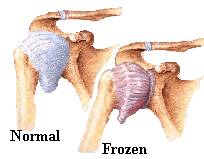Brief Outline of Frozen Shoulder (Adhesive Capsulitis)
Frozen shoulder or adhesive capsulitis causes severe restriction of shoulder movement due to pain. The condition results from abnormal bands of tissue that form between joints, thereby restricting their motion and producing pain. Synovial fluid – which usually serves to lubricate the space between the capsule and ball of the humerus in the shoulder, allowing smooth motion – is often lacking in this condition. It is more common in females.
Anatomy and physiology
Frozen shoulder involves injury and accompanying loss of movement in the shoulder or glenohumeral joint. The joint consists of a ball (formed by the humeral head) and socket (the glenoid cavity). While the glenohumeral joint is normally one of the body’s most mobile joints, it is inherently unstable due to the gleonoid cavity being only approximately one-third the size of the humeral head, (although it is slightly deepened by a rim of fibrocartilage called the glenoid labrum). The joint capsule appears to be a major cause of movement limitation in this condition. Adhesions of scar tissue forming in joint spaces can restrict movement, causing the shoulder to freeze up, with severely limited range of motion.
Cause of Frozen Shoulder
Scar tissue formation following shoulder injury. Formation of adhesions following shoulder surgery. Repeated tearing of soft tissue surrounding the glenohumeral joint.
Signs and symptoms of Frozen Shoulder
Dull, aching pain in the shoulder region, often worsening at night. Restricted movement of the shoulder. Pain and ache when lifting the affected arm.
Complication if left Frozen Shoulder unattended
Frozen shoulder has a tendency to worsen over time without adequate treatment and proper recovery period. Attempted athletic activity, involving the affected shoulder, will likely lead to further adhesions of the joint, with further pain and restrictions of movement. Production of scar tissue may eventually require surgical removal.
Treatment for Frozen Shoulder
- Injection
- Manipulation under anaesthesia to loosen the joint and break up the scar tissue
- Key-hole surgery to remove the scar tissue
Rehabilitation and prevention for Frozen Shoulder
Most heat should be accompanied by stretching exercises to gradually restore mobility. Heat therapy should be combined with doctor-supervised physical therapy. Moving the shoulder through the full range of motion several times daily, as well as strength training exercises, may help avoid frozen shoulder. Injuries to the shoulder should be given prompt medical attention to avoid formation of scar tissue, where possible.
Long-term prognosis for Frozen Shoulder
The length recovery time following frozen shoulder varies depending on the underlying cause as well as the age and health of the athlete, and the history of shoulder injury. If the condition fails to improve after 4-6 months, surgery may be required. Some lasting discomfort and impairment of movement is common with this injury.




